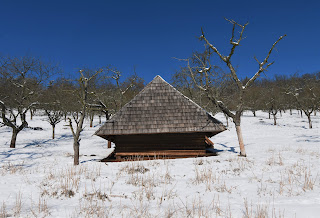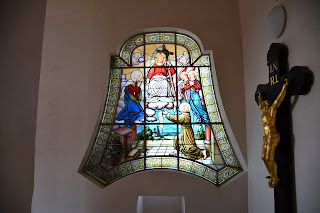Journey to the Southwest
The weather remained very pretty for the rest of the weekend, so I convinced my dad and my sister to go on a trip in the direction of Plzeň. I did not bother to convince my dog, of course, but took her anyway. The first place we visited were the castles Točník and Žebrák, which my sister and I made a brief excursion to last year in much worse weather (it was so foggy that it was impossible to see either of the castles from many of the places where I took pictures today). Unlike last time, the goats who live under Točník ventured out of their pens and showed their interest in visitors, which indicates that they are often given snacks. Despite the beautiful weather, we didn’t meet too many people.
Our second
stop was Zbiroh Chateau, which lies just over the border of Central Bohemia in
the region of Plzeň. Unfortunately, the grounds of the chateau were closed, so
there were no good places nearby from which we could see the building. We decided
to view it from a nearby hillside instead. Zbiroh was founded in the fourteenth
century as a castle, but was turned into a neo-renaissance-style chateau in the
late nineteenth century by a baron who soon went bankrupt and had to sell it to
the Colloredo-Mansfeld family. Alfons Mucha painted the Slavic Epic during his
sojourn at Zbiroh between 1912 and 1928.
We reversed
course from Zbiroh in the direction of Hořovice, where I hoped to visit the
grounds of Hořovice Chateau. Although we were convinced that this chateau was
also closed, we eventually found the entrance, which we initially mistook for
an employee entrance. The grounds were larger and more interesting than I expected,
with an allée of imposing deciduous trees leading to the northern gate and
another, more unusual allée of willow trees to the south of the first.
We also saw
the statue of Friedrich
Wilhelm, last Prince-elector of Hessen-Kassel and erewhile owner of Hořovice
Chateau. Friedrich Wilhelm was unpopular in Hesse, where his reactionary politics
and pro-Austrian orientation did not win him many friends. He was also disliked
for his untraditional lifestyle, making no secret of his mistress and mother of
eight children, and marrying a divorced woman far below his station. Friedrich
Wilhelm bought the chateau and several other properties for his children, who
would otherwise have been left with nothing following the occupation of Hesse
by Prussia in the Austro-Prussian War. He died in Prague in 1875.
Our
last destination was the Holy Mountain in Příbram, a baroque complex built in
the seventeenth century. Příbram’s Holy Mountain is one of
the most important pilgrimage sites in the Czech Republic and can be visited
when travelling down the Camino de Santiago through Bohemia. As the lavishly
ornate exterior indicates, much of the Holy Mountain complex was designed by
Italian architects amidst Bohemia’s forcible re-Catholicisation, with the
generous financial support of the Jesuit order.

























































Comments
Post a Comment